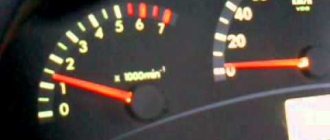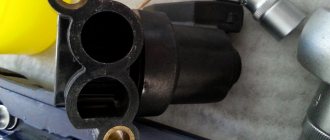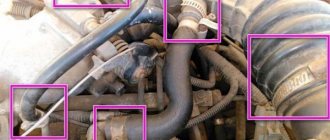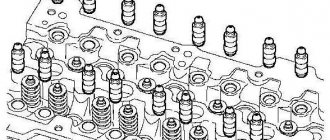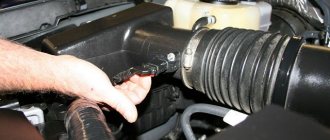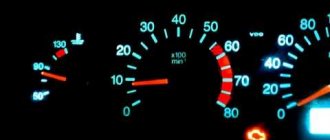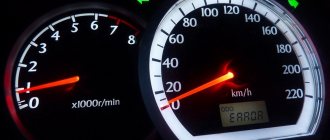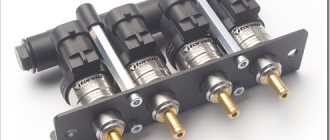If the engine is working properly, when the car starts to start, a warm-up process occurs. At this time, the tachometer needle shows almost 2.5 thousand revolutions per minute; after warming up, the speed decreases. Subsequently, the normal functioning of the power unit is characterized by the tachometer needle being at a level of 750 to 800 rpm.
If a problem arises - the speed fluctuates on a cold engine, this can only mean one thing - serious defects have appeared in the car’s engine, so it works unstably.
In the absence of this device, violations can be determined by the sound coming from the power unit compartment: the rumble and vibration of the engine are noticeable in the form of an increase and decrease alternately. Most often, the engine speed jumps at idle.
Possible reasons
If the speed fluctuates when cold, this is not due to a malfunction of one particular sensor or mechanism. If the internal combustion engine is unstable, you need to diagnose each system in turn:
- Intake tract. Air leaks in the intake system are the most common cause of floating speed when cold.
- Fuel system. We look at the filter, pump and injectors. The latter should be given special attention, especially if it is a diesel engine. Yes, the car starts and pulls up any incline, but when it’s cold, the engine won’t hold speed.
- Sensors Check the mass air flow sensor, air sensing sensor, lambda probe, and idle air control valve. They may be excessively dirty, or may not work due to a short circuit or poor contact.
- Cylinder-piston group. If the compression measurement showed disappointing results, the reason is precisely the CPG.
Malfunctions
The peculiarity of the idle speed sensor is that it is impossible to trace the occurrence of a malfunction due to the operation of the on-board computer. The system does not recognize a breakdown, so everything has to be done manually.
There are several characteristic signs that can tell you about problems with the XX sensor:
- The car often stalls when idling;
- A phenomenon called floating speed occurs;
- There are no increased speeds when starting a cold engine;
- If the gear is switched off, the engine may stall spontaneously.
There are also a few errors on the on-board computer, but you shouldn’t rely solely on them.
Error code
What does it mean
Low idle speed
Increased idle speed
Many people confuse the signs of IAC failure with the throttle position sensor. The symptoms are indeed very similar. But the point is that the on-board computer signals a breakdown of the position sensor, but regarding the IAC it is silent.
Diagnostic methods
Before proceeding with the replacement, we recommend that you really make sure that the cause of all problems with your VAZ 2114 is the faulty IAC. To do this, there are two main ways to check the status of the device.
Explore both to see which diagnostic option is best for you.
First way
- Get a tester if you haven't had one before.
- Disconnect the DXX from the block with wires.
- If you have a 1.6-liter engine, then be sure to disconnect the throttle assembly fasteners and move it from the receiver about 1 centimeter.
- Use a voltmeter to check if voltage is being supplied to the regulator. The minus is connected to ground, and the plus goes to the block - use the AD pins.
- With the ignition on, the tester should show at least 12 W.
- If there is no voltage, then there is a problem in the power circuit or electrical unit of the car.
- If there is voltage, but it is significantly less than 12W, then this indicates a low charge level of your battery. Be sure to recharge the battery.
- After checking the circuit for efficient operation, proceed to study the DXR itself. At this stage the ignition is turned off.
- In turn, connect the terminals to the tester to pairs A-B and CD. The normal resistance should be approximately 53 ohms.
- Change the pairs to AC and BD. When measuring them, the resistance should turn out to be infinitely large.
Could it be due to the battery?
Let's dispel all the myths right away.
No matter how “dead” the battery is, it will not cause the speed to jump after a cold start. The starter may turn slowly, but the engine will run normally after starting.
It's another matter if the battery warning light flashes at idle. At the same time, the instrument panel lights flicker, the lights strobe, and the car’s revs fluctuate. Why is this happening? A faulty generator cannot provide normal voltage for the operation of all engine systems. In this case, you can hear a characteristic noise or whistle from under the hood. Usually brushes, voltage regulator, bearings and diode bridge fail.
The conclusion is this: if the revs fluctuate when starting from cold, and the battery light is on, look towards the generator.
Loss of speed when starting the engine when hot
- Registration
- Entrance
- To the beginning of the forum
- Forum Rules
- Old design
- FAQ
- Search
- Users
So my problem was that during the launch the DPZ showed 3-6 percent. and precisely at an engine temperature of about 20 degrees.
Good day everyone! I still have a problem with starting the engine. It started with the fact that immediately after starting the engine at a certain temperature (10-25 degrees Celsius), the engine does not run smoothly for 2-5 seconds, but does not fluctuate, the speed fluctuates by ear, is underestimated, about 1000, but the tachometer does not reflect the swimming, the BC shows a slight floating of about 50 rpm, if immediately after starting you lightly press the gas pedal for a split second and release, then the rpm immediately reaches the warm-up speed, about 1200-1500, and in the future this problem does not recur, now this The problem began to appear when starting a hot engine, if it sits for about 5-10 minutes, after turning off the ignition, everything is the same, only the speed is lower, no errors appear. When starting the engine at a temperature below 5 degrees, everything works fine, it immediately warms up and that’s it. The mileage is 35k, the problem started at about 4k, it does not appear all the time, out of 3-4 starts one is with a drop in speed.
Same problem. When it warms up to 36 degrees, the revs start to fluctuate and the engine twitches. It seems that this happens at the moment the calculation of the mixture is switched to the oxygen sensor (after it warms up).
_________________
Same problem. When it warms up to 36 degrees, the revs start to fluctuate and the engine twitches. It seems that this happens at the moment the calculation of the mixture is switched to the oxygen sensor (after it warms up).
Source
Air leak in intake
These are cracks in the intake manifold, hoses, leaky connection of pipes or breakdowns in the vacuum hose of the brake booster. Often air gets trapped at the junction of the throttle valve and the manifold. Air that is not taken into account by the sensors enters the system, which changes the composition of the fuel mixture.
Broken pipe
The control unit cannot adjust the mixture, because “on paper” everything is clean - exactly as much oxygen as needed has passed through the sensors. On some cars, the ECU still tries to correct the injector corrections, but cold engine operation still remains unstable. By the way, as it warms up the problem may disappear. Why? As the temperature increases, engine parts expand, and if air is sucked in, it is only slightly, without causing problems when the car operates.
If the speed fluctuates on a cold engine, the problem may be hidden by a “sagging” intake manifold gasket, which is completely impossible to notice with your eyes. Visually there are no cracks, there is nowhere for air to get in, and even when hot, the speed levels out. Do not rush to open the manifold - air leaks can be checked with a smoke generator.
Smoke generator
Such a device is available at many service stations. The technician runs a smoke generator into the intake system and controls where the leak is coming from. This is a quick and accurate way to determine leakage, and most importantly, it is absolutely safe for the engine.
Methods for eliminating floating engine speeds
When starting to find and eliminate the reasons that cause unstable operation of the engine in idle mode, you first need to check:
- Condition of the air filter and spark plugs. If they become critically dirty, they need to be replaced.
- Integrity of insulation of high-voltage wires. If damage is found, they must be replaced.
It is recommended to make sure that there is no suction at the junction of the intake manifold with the engine cylinders. To do this, with the engine running, you need to sequentially spray all joints at the joints with carburetor cleaner or other flammable liquid. If atmospheric air enters there, the car engine jerks sharply, which is why, if a damaged gasket or plug is detected, the element is replaced.
Checking the tightness of the intake manifold (video guide)
Let's consider the remaining elements of the car, the malfunction of which can affect the smooth operation of the VAZ 2114 engine in idle mode.
Solenoid valve diagnostics
Cars with engines equipped with a carburetor are equipped with idle speed solenoid valves. Devices are checked as follows:
- Disconnect the power cord.
- Start the engine to warm up.
- Connect the wire. If a clear click is not heard, the part must be replaced.
Attention! To fully ensure that the valve is working properly, be sure to clean the nozzle and repeat the test.
Is the EGR system on the injector working?
"Floating" speed can be caused by jamming of the exhaust gas recirculation (EGR) valve, which is installed in the exhaust manifold. It is necessary to periodically remove dirt from the valve seat and its seat using a carburetor cleaning aerosol, avoiding liquid getting on the sensor diaphragm.
Keep the valve seat clean
Attention! If cleaning the unit does not give a positive result, the device must be replaced.
Adjusting the idle speed on a carburetor engine (with video)
Note that the main reason for the appearance of floating idle speed in engines of this type is the incorrect operation of the carburetor. The device is adjusted by rotating the fuel quality and quantity screws.
Is the idle air control valve working correctly?
The IAC is checked by measuring the electrical resistance at the contacts - to diagnose the device you will need a tester (multimeter) set to the “ohmmeter” operating mode. To check the details:
- Let's turn off the ignition.
- Disconnect the connection block.
- Let's measure the resistance on contacts A - B and C - D of the device. The optimal readings of the device vary from 40 to 80 ohms.
- Let's repeat the measurements with contacts B - C and A - D. In this case, the multimeter should show “infinity” or an open circuit.
Any violation of the normal resistance values means a malfunction of the regulator. IAC failure is a common cause of floating engine speed at idle, and if a malfunction is detected, the device must be replaced. Before you begin dismantling the part, you must disconnect the negative wire from the battery. After installation, the new IAC is calibrated - the removed terminal is returned to its place, the ignition is turned on and after 5-10 seconds (there is no need to start the engine).
IAC failure is a common cause of floating engine speeds.
Attention! If the battery is not disconnected before dismantling the device, the electronic control unit will not calibrate the IAC.
Cleanliness of the damper assembly
The throttle valve assembly is diagnosed by visual inspection for contamination. Clean the part with cotton swabs and a toothbrush moistened with a cleaning solution. For ease of work, the device is dismantled. After cleaning, it is recommended to blow out all channels and pipes of the unit with compressed air using a tire inflator.
To clean the part, it must be dismantled
Attention! It is recommended that the channel responsible for removing gases from the crankcase be completely filled with a cleaning solution before purging - the diameter of the element is very small and there is no other way to access it.
Video: How to clean the throttle body
Is it possible to diagnose DPKV and DSA?
A breakdown of the DPKV and DSA (Hall sensor) is indicated by the Check Engine indicator that lights up on the car’s dashboard. Testing these devices is only possible using special instruments (oscilloscopes). You can first check the integrity of the wiring; if it is broken, the damage should be repaired.
- The DPKV sensor is installed on a bracket located in close proximity to the generator drive pulley.
- The DSA is located on the speedometer drive mechanism of the gearbox.
For a more detailed introduction to methods for detecting faults associated with engine malfunction in idle mode, it is recommended to watch the following video.
Video: Computer diagnostics of VAZ 2114 idle problems
So, the main steps to rid the car of floating engine speed at idle are considered. Remember: if performing these operations yourself does not lead to a positive result, you will have to contact a service station with the necessary diagnostic equipment and qualified repairmen.
Low fuel pressure
We begin the check with the elementary - fuel filters. There are two of them - coarse and fine cleaning. The first is located together with the pump (usually in the tank), the second is under the bottom or in the engine compartment. The coarse filter should be changed every 100 thousand kilometers, and the fine filter once every 30 thousand. Replacement may be required earlier if bad fuel was accidentally filled in.
If after replacing the filters the car still does not hold speed, starts poorly when cold and may stall, check the fuel pressure regulator.
Fuel pressure control
On a car with high mileage, the valve membrane is damaged, causing the engine to not receive the required amount of fuel. Fortunately, the part is inexpensive and can be changed quickly.
If diagnostics show that the old regulator maintains fuel pressure, the pump may be the cause of all the troubles. The blades, bearing or the electric motor itself may be faulty.
Popular brands:
Audi RS 7, Mazda CX–7, Skoda Octavia
Idle speed control
The regulator tends to become dirty at a distance of more than 100 thousand kilometers. Because of this, the regulator rod begins to jam, and sometimes jams in one position. The speed fluctuates when cold, sometimes even when hot. At the same time, the motor rotates without problems under load.
Idle speed control
There are two options for solving the problem - disassemble and clean the old regulator, or replace the IAC with a new one. It is important to know that Chinese substitutes quickly fail, so try to buy original IACs or analogues from trusted manufacturers.
Sensors
We inspect all sensors that may affect engine idle operation. These are the sensors:
- mass fuel consumption;
- throttle position;
- internal combustion engine temperatures;
- absolute air pressure;
- intake air temperature.
The engine ECU receives information from the sensors based on their voltage, which varies under different conditions. If the contact is bad or damaged, the data will be incorrect.
The ECU will incorrectly adjust the mixture or go into “emergency mode” - try to at least somehow maintain the speed, just so as not to stall the engine. It’s not necessarily a matter of wiring - despite the simplicity of the device, the sensor itself can also become unusable. There are frequent cases when owners installed sensors that were not suitable for a specific internal combustion engine or sensors from unknown manufacturers, which is why the speed problem did not go away.
Only after proper diagnostics will it become clear which sensor is faulty and requires replacement.
Do-it-yourself troubleshooting
Many faults from the above list can be eliminated yourself in a few minutes. It will take much more time to identify.
Diagnostics of mass air flow sensor and IAC
The mass air flow sensor and idle air control act as regulators of air supply to the combustion chamber.
We have already written in more detail about diagnosing the air flow sensor; you will need a multimeter!
Failure of these sensors will lead to an increase in fuel consumption, and a broken rod will affect the speedometer needle; it will remain motionless until the problem is fixed.
Checking the functionality of the idle air regulator
Checking the performance of the mass air flow sensor
If any malfunctions are detected, the idle air regulator must be replaced with a new one!
IAC failure and serviceability of the mass air flow sensor
Failure of the required regulator is one of the main reasons for the appearance of floating speed, which leads to dismantling the device. Here it is very important to leave the power supply turned on, because the electronic unit itself will not calibrate. The air flow device needs to be cleaned with a special aerosol for carburetors, although this action does not always help! In this case, replace.
If necessary, clean the throttle valve with a brush and cotton swabs, after moistening them with a solution, and blow all channels and pipes with air from the tire inflation pump.
We recommend: Arranging the exterior of your car
The channel that removes gases from the crater is completely filled with solution, because the diameter of the crater is small and there is no other way to perform this operation.
The article discusses the main points of work to eliminate floating speed in the car at idle. If everything is done according to these instructions, the problem will be eliminated, but if a positive result is not achieved, be sure to contact a service station for help from qualified technicians. Without solving this problem, it is not safe to use the machine!
Diagnosis of DPCV
Crankshaft rotation sensor location
Failure of the crankshaft position sensor will negatively affect the operation of the engine as a whole. A failure in synchronization between the engine and the injection system will result in the car not starting. You can accurately determine the condition of the sensor only by using a multimeter.
To do this you need to do the following:
- Set the sensor to a position with a maximum value of 200 mV;
- Connect the multimeter and close the core with a screwdriver;
Checking DPKV with a multimeter
- The voltage should jump; in case of a negative reaction, the sensor must be replaced.
Video about checking the crankshaft rotation sensor
Lambda probe diagnostics
Location of the oxygen sensor (lambda probe)
The sensor reads the amount of oxygen in the exhaust gases and sends a signal to the computer to increase or decrease the air supply to the combustion chamber. Diagnostics is performed with a multimeter on a warm engine. The procedure is as follows:
- One core of the device clings to the ground, the second to the output from the sensor;
- When re-gassing the engine, the multimeter readings should be in the range from 0.2 to 0.9 V;
When checking the lambda probe, the voltage readings should be within 0.2 - 0.9V
- Other readings indicate the need to replace the sensor.
Video about checking the lambda probe
Speed sensor diagnostics
Speed sensor
The vehicle speed sensor is located in the gearbox. Its diagnosis is carried out by visual inspection of wires and contacts . If oxide is detected, it must be thoroughly cleaned.
Replacing the air filter and glow plugs
Air filter for VAZ-2114
The presence of a large amount of dust on the body and inside the air filter requires its immediate replacement.
Since its throughput is reduced, the engine does not have enough air in the combustion chambers . Due to this, the fuel does not burn completely, and the remaining fuel is thrown out and burns out in the exhaust pipe, which can burn out as a result.
Changing the air filter
We clean carbon deposits or replace spark plugs
Heavy carbon deposits on the spark plugs or any mechanical damage to the housing require their replacement.
Oil deposits on spark plugs
Important! If the machine was operated with this malfunction, it is recommended to replace the spark plugs, since, due to high fuel consumption, they will be flooded.
Checking wires
The easiest way to diagnose high-voltage wires is in the dark; to do this, just open the hood. If the wire is “broken,” a spark will be visible striking to the side .
Visual inspection of high-voltage wires
Another reason lurking in this place is poor contact, the appearance of oxide. To do this, you need to visually evaluate the wire tips (white, blue or green coating); you need to thoroughly clean them, wash them with Wedge (WD-40), dry them and put them in place.
Healthy! Don't forget about the term "metal fatigue". This refers to the deterioration of current conductivity due to the fact that the contacts are in constant voltage mode. Therefore, high-voltage wires should be periodically replaced with new ones (their specific service life depends on the manufacturer and is indicated on the packaging).
Checking the intake manifold
Most often, air leaks occur through the connection of the intake manifold to the cylinder block . This happens due to wear of the gasket. This is not difficult to identify. To do this, you will need regular carburetor cleaner. With the engine running, you need to spray the can on all connections and places that cause you suspicion (microcracks in the commutator body itself are also possible).
Checking the intake manifold
If the engine runs without changes, then the cause of the malfunction is not here. If the engine speed increases and the engine jerks, the manifold or intake manifold gasket should be replaced.
Healthy! There is no need to solder and glue the intake manifold. The patch will not stay in place for long and after a while the problem will arise again.
Cleaning the throttle valve
The throttle valve needs regular cleaning of carbon deposits.
Due to heavy carbon deposits, the throttle valve may be in an incorrect position. To fix this, you will need to remove the throttle assembly and clean it with a carburetor cleaner or carburetor cleaner, and then reinstall it.
Healthy! The assembly should be washed thoroughly; you can soak it in gasoline for a while.
Floating speed is a standard disease of injection engines. The fact is that the ECU, when receiving an incorrect signal from a non-working sensor, mistakenly opens the air supply solenoid valve . The TPS gives a signal that this cannot happen, and the engine has already left the warm-up mode. It is at this moment that the idle speed of the VAZ-2114 begins to float. Therefore, if such a problem appears on your car, do not be upset. If the cause is detected and eliminated in a timely manner, there is nothing to worry about.
Oxygen sensor
It is also a “lambda probe”. A sensor that analyzes the percentage of carbon dioxide in the exhaust. Interacting with the lambda, the ECU adjusts the mixture entering the combustion chamber. Note that this sensor only works in warm mode (from 300 degrees) - at a time when the probe is not warmed up, a slight fluctuation in revolutions is possible. This should happen for no more than 20 seconds.
Oxygen sensor
But if the engine continues to mope even at operating temperature, it is worth examining the lambda in more detail. Often this sensor becomes dirty or the contacts bend, causing the output voltage to change (more than 0.45 Volts) and the unit receives incorrect data. If computer diagnostics show errors in the lambda (there may be several of them), it is worth replacing the sensor and checking the engine operation again.
In general, the lambda probe is a common problem, both on our cars and on foreign cars. With our fuel quality, the sensors do not last more than 100 thousand kilometers and, from time to time, cause headaches for owners.
You can solve the problem radically - install “decoys” or reflash the ECU for Euro-2, while removing the catalysts. Or leave everything as is and just change the sensors periodically.
Choosing an auto electrician - main features
Most problems with increased speed, increased fuel consumption, and unstable idling are solved by an electrician.
This specialist finds problems in the electrical part of the car, diagnoses all components, and carries out repair work in the electrical part. You are unlikely to figure this out on your own; you will have to try hard to study the wiring diagram for all the parts of your car. And finding the location of all the sensors is often difficult, especially in a technologically complex modern car. So you need to entrust the work to an experienced craftsman. When choosing an auto electrician, consider the following features:
official service - in most cases this will be the best solution, since here specialists work only with one specific brand of car and provide a guarantee of quality; the equipment of the service station plays an important role in identifying potential problems in your car; you just need to make sure that the station is well equipped and has normal equipment; experience of a specialist - pay attention to who exactly will service your car, the technician must be quite experienced, it is better to check reviews about him from different sources; a good option is to choose an electrician by recommendation; if you do not use the services of an official station, the recommendations of your friends will help you find the optimal service; It is worth starting cooperation with diagnostic services; diagnostics will show how competent the specialist is and whether there is any point in further cooperation with these specialists.
As you can see, there are several ways to check a person’s competence and make sure of his professionalism. If you decide to have your car serviced at an unverified station, be sure to be present during the repair and monitor every step of the technician. This is your right, it is quite possible to be present during repairs even in a garage station, where not a single master will like it. You can leave your car unattended either with the officials or with a trusted service that you have been working with for quite a long time. Keep this in mind the next time you need to go get your car repaired.
We also suggest watching a video about car diagnostics:
Wear of CPG parts
At first, this problem may only occur when the engine is started cold. The owner will notice terrible vibrations and a slight deviation in idle speed. As they warm up, the parts of the cylinder-piston group expand and the backlash goes away. The motor works as it should. But as soon as it cools down, the vibrations repeat again.
Wear of the cylinder-piston group
If you notice this feature, check the compression in the cylinders:
- for gasoline engines the normal value is from 10 to 14 Bar;
- for diesel engines - from 20 to 28.
The pressure difference across the cylinders should be no more than 10 percent. If the results are disappointing, it is worth performing an endoscopy of the engine. It happens that the “hon” on the walls is intact, but the compression is still low. There are several reasons. One of the simplest ones is burnout of the cylinder head gasket. If the gasket is intact, look at the valves and rings.
Occurrence of rings
A common cause of low compression is coked rings. This occurs due to the use of bad oil or fuel, or untimely maintenance. Decarbonization will help solve the problem, but this requires disassembling the engine.
avtoexperts.ru
The engine is the “heart” of a car, and like the human heart, interruptions sometimes occur in the functioning of this “organ”. We become aware of problems with the engine by reading the rpm. If the speed of the power unit begins to float, the engine gives us a signal that something is wrong with it. In our material today we will tell you what breakdowns are hinted at by jumping engine speeds, how to correctly diagnose and repair them.
The reason for the appearance of floating speed
The driver can find out that there is something wrong with the engine speed by looking at the tachometer. During normal operation of the power unit at idle, the needle of this device remains at the same level (usually within 750-800 rpm), and if the engine has problems, the needle either falls or rises (range from 500 to 1,500 rpm and higher). If the car does not have a tachometer, then the floating speed can be heard by ear: the rumble of the engine either increases or decreases. And also - by the increasing and decreasing vibrations penetrating into the car interior from the engine compartment.
As a rule, unstable engine speed occurs at idle. But even at intermediate engine speeds, dips or rises in the tachometer needle can be detected - this is typical for diesel engines. Let's consider these two cases separately to understand why these phenomena occur.
Why do carburetor speeds fluctuate?
If the cold speed of a carburetor engine fluctuates, it could be:
- Incorrect carburetor setting. Often it is not possible to adjust the idle jet.
- Diaphragm wear. When cold, the material may become stiff, causing the speed to fluctuate.
- Carburetor gasket. It also gets dull and causes air leaks. Typically, as it warms up, the material softens and the speed levels out.
- Solenoid valve. If it does not make a click when connected directly, the part must be replaced.
How to eliminate jumps in engine speed at idle
The actions of the car owner or mechanic at the service station depend on the detected defect. Typically, you need to follow these steps:
1. Adjusting the carburetor or replacing the EM valve.
In the latter case, the internal combustion engine operates only with the choke pulled towards itself.
2. Check for additional air entering the combustion chamber.
To do this, the entire path of air supply to the intake manifold is studied. The test is carried out by removing the tubes one by one and testing them under pressure. A special supercharger is used for operation. To simplify the search, you can use WD-40. After treating the tube at the problem area, the liquid quickly evaporates. The product cannot be “repaired”, so the only solution is to replace it.
3. Cleaning the throttle valve with further installation and adjustment
. The product can be cleaned in two ways - after dismantling or without removing it from the car. When choosing the first method, you need to discard all the tubes that go to the problem node, reduce the fixation and remove the product. To clean the throttle valve, the assembly is placed in a basin and filled with a special compound. To speed up the process, use a soft bristle brush. After washing, wipe the assembly with a clean rag and return it to its place.
The second way is to clean the throttle element without dismantling it. To do this, remove the explosive wires, run the cleaning composition into the device, start the internal combustion engine and additionally add cleaning fluid. After work, a white exhaust may come out of the pipe. This phenomenon indicates the removal of excess contaminants. After completing the procedure, return the wires to their place, connect the PC and enter the desired program (a suitable gap is set). If the work is done correctly, the idle speed will not fluctuate.
4. Installation of a new XX regulator.
To assess the condition of the device, take a “tseshka” and change the resistance. When receiving a parameter ranging from 40 to 80 Ohms, the IAC is broken and requires replacement.
5. Installation of mass air flow sensor.
If the sensor that controls air flow breaks down, the only solution is replacement. There is no point in repairing the part.
6. Regulation of XX.
If the idle speed is floating, you can solve the problem by adjusting it with a screwdriver. The work is carried out by changing the position of special screws, adjusting the quality and volume of revolutions.
7. Cleaning the crankcase ventilation.
To solve the problem, you will have to disassemble the crankcase and remove the valve. The product is lowered into a container with cleaning liquid, dried and returned to its original position.
8. Installation of a new carburetor EM valve.
If this element fails, the motor operates stably with the choke extended. To solve the problem, we change the EM valve and check it.
9. Cleaning the fuel injection pump blades from rust.
You will need a cleaning compound that needs to be sprayed onto the neck of the fuel tank. In the future we will add some engine oil to the tank. The composition will settle on the fuel injection pump blades and protect the metal from rust.
10. Cleaning the XX jet.
15-20 years ago, performing such work caused many difficulties for car owners. Now there is no problem with this. It is enough to buy a special composition and wait 5-10 minutes. Next, remove the jet and remove any remaining dirt.
In a situation where the engine speed fluctuates, other work may be required - replacing spark plugs, installing new sensors, adjusting the ECU, etc. If there is no experience, a specialist should find out the cause of the malfunction. He should be entrusted with car repairs. Many car owners put off work “for later”. This cannot be done. It is better to immediately come to the service station, do an in-depth diagnosis and eliminate the cause of the malfunction.
Video review of useful tips for adjusting engine speed:
Why do diesel engine speeds fluctuate?
We immediately look at the fuel injection pump. Over time, rust can develop in the pump. Natural wear and tear should not be excluded. As a result, fuel is supplied to the injectors under low pressure, injection occurs too early, and detonation occurs. If you're lucky, you can limit yourself to adjusting the injection advance. In the worst case, a complete repair or replacement of the fuel injection pump.
High pressure fuel pump
A diesel engine may also suffer due to EGR. The recirculation valve sticks, causing the speed to fluctuate when cold. Cleaning or replacing the valve helps eliminate the problem.
What to do to fix the problem
As we have already seen, the problem of floating speed can be hidden in different places. Therefore, if you notice unstable engine operation, you need to seek diagnostics in time. Experienced DDCAR specialists will help determine the cause of the malfunction and eliminate it as soon as possible.
Engine diagnostics
Correct diagnosis is 90% of success in solving a problem. You should not spend money prematurely on purchasing sensors and other parts in the hope that after replacing them the problem will go away. There's a good chance it will be wasted effort. Listen to your car, have it serviced at trusted service stations and contact experienced diagnosticians!

